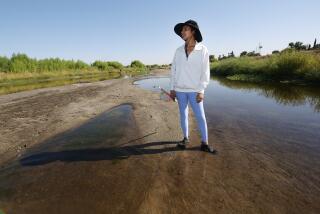Salmon Die-Off Reignites Feud Over Klamath River Water
Thousands of salmon have died in the Klamath River in Northern California since last week, raising anew questions of whether the federal government is diverting too much water to farmers at the expense of fish.
“There’s so many dead fish around and only so many hours in the day to count them,” said David Hillemeier, a fisheries biologist with the Yurok Indian tribe. “There’s some sick ones, some have sunk to the bottom of the river, and some have washed up. Every few feet there’s a dead salmon, for as long as you can see.”
At least 1,500 have been counted so far, with at least a few thousand to go, according to Paul Wertz, an information officer with the California Department of Fish and Game.
Most of the dead fish are either wild or hatchery-raised 15- to 20-pound adult chinook salmon that in recent weeks have left the Pacific Ocean to migrate up the Klamath and reproduce. Last year, the Department of Fish and Game estimated that 189,214 chinook--also known as king salmon--entered the Klamath in the fall.
Wertz said that biologists have also found some dead steelhead and federally endangered coho salmon.
Wildlife officials suspect that the fish are being killed by “gill rot,” an affliction that prevents the salmon from breathing. The rot is probably caused by several factors, including high water temperatures and too many fish crowded together, both conditions caused by low flows.
“The biologists told me that many of these dead fish are very bright and healthy looking, except for the part about them being dead,” Wertz said. “The condition of the gills was startling to the biologists.”
Officials with both state and federal agencies said the die-off is the largest in the region in recent years. The kill is also the latest chapter in a controversy over how much water should be left in the Klamath River and its tributaries, and how much diverted to farmers in the Klamath Basin, located on the Oregon-California border.
Last year, much of the farmers’ usual allotment was reduced to supply more water to salmon, which inhabit the 190 miles of the Klamath River below Iron Gate Dam.
Following an outcry by basin residents--who accused the government of favoring fish over people--the opposite occurred this year. The farmers got their full allotment of water, while flows in the Klamath were reduced this summer by 20% to 30% of what they were in 2001.
Angry commercial fishermen and environmentalists argue that the lower flows are to blame for the die-off. “It’s a disaster that didn’t have to happen; it was created by government policy that for decades has ignored the lower river and confiscated all the water for farmers,” said Glen Spain, Northwest regional director of the Pacific Coast Federation of Fishermen’s Associations, which represents the commercial fishing industry.
Jeff McCracken, spokesman for the U.S. Bureau of Reclamation, said that the agency is releasing flows according to guidelines spelled out by the National Marines Fisheries Service.
“No one likes to see anything like this happen,” he said. “But this was a dry year, and people need to recognize that flows out of Upper Klamath Lake would probably exacerbate the problem because ... the water in that lake is very warm” and the fish need cold water.
Exactly how much flow is needed to support salmon and other fish in the Klamath has been the subject of intense debate.
Guidelines set by the National Marine Fisheries Service in 2001 were criticized as lacking sound scientific basis by the National Academy of Sciences, which is working on its own report on what flow levels should be.
Nearly every major tributary that runs into the Klamath--most notably the Trinity River--is depleted by diversions, mostly for agriculture. Although the Klamath Basin diversions have received most of the attention, officials suggest the larger problem is that too little water from throughout the watershed is being allowed to reach the sea.
More to Read
Sign up for Essential California
The most important California stories and recommendations in your inbox every morning.
You may occasionally receive promotional content from the Los Angeles Times.










